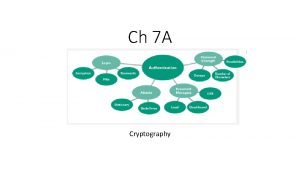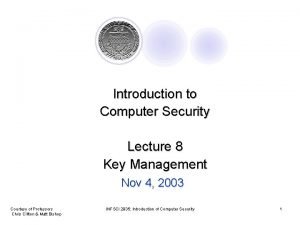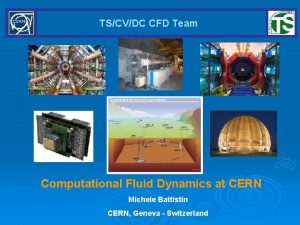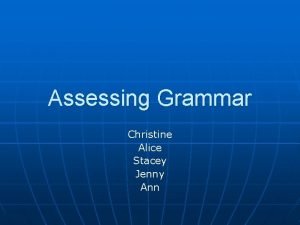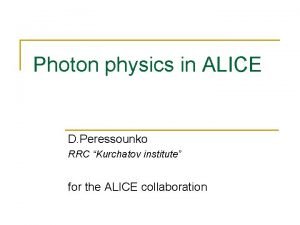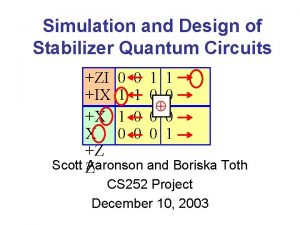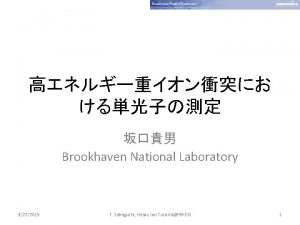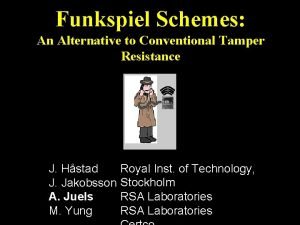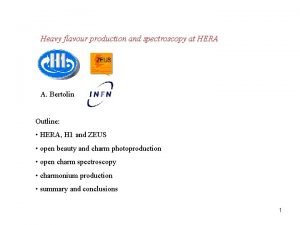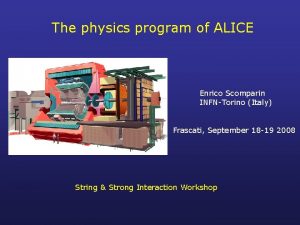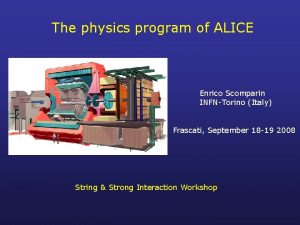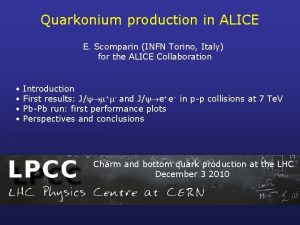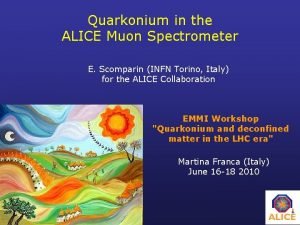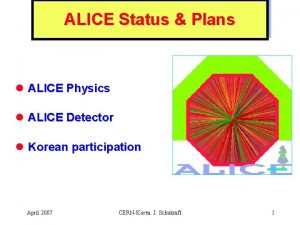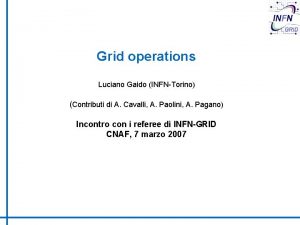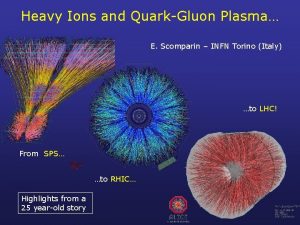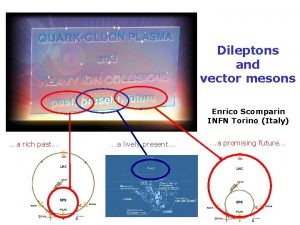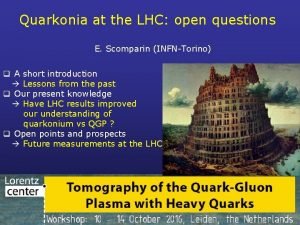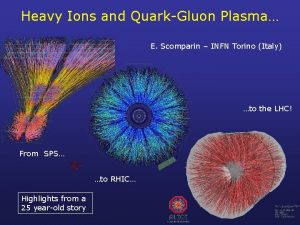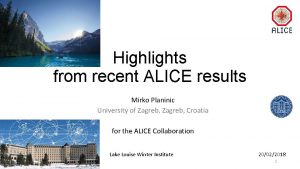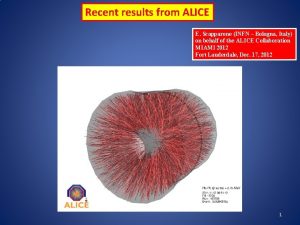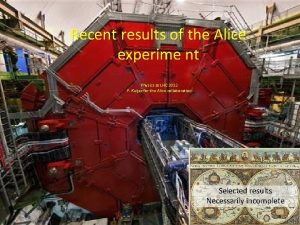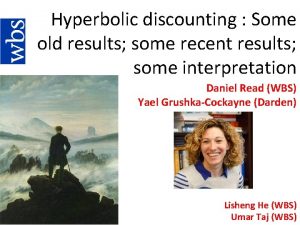Overview of recent ALICE results E Scomparin INFNTorino
































































- Slides: 64

Overview of recent ALICE results E. Scomparin (INFN-Torino) q A short introduction Heavy ions at the LHC q The ALICE experiment Characterization of the QGP q The physics program q Global observables The most liquid that ever existed q Light flavors and strangeness The chemistry of the QGP q Hard probes Transport properties of the QGP q p-Pb vs Pb-Pb a reference or more? q Open points and prospects The future of ALICE E. Scomparin, Overview of recent ALICE results, Kruger, December 2016 1

Heavy ions at the LHC q Investigate the region of the phase diagram of strongly interacting matter corresponding to the highest possible temperature and the lowest possible net baryon density Critical point q Re-create the first (and hottest!) liquid that ever existed and that gave rise to matter around us…. …and study its properties in the laboratory! E. Scomparin, Overview of recent ALICE results, Kruger, December 2016 2

The energy frontier q Evolution of (some) properties of the system with the collision energy (N. B. approximate values!) Central collisions SPS RHIC LHC s (Ge. V) 17 200 5000 (today) d. Nch/d ( =0) 450 650 2000 Energy density (Ge. V/fm 3) 2. 2 -3. 2 5. 4 20 V (fm 3) (from HBT) 120 160 300 Decoupling time (fm/c) (from HBT) 6 7. 5 10. 5 Average QGP temperature (Me. V) (photons, dileptons) 190 240 300 LHC hotter, larger and longer lived fireball! E. Scomparin, Overview of recent ALICE results, Kruger, December 2016 3

A complex (and long!) endeavour q (Almost) exactly 30 years ago: first heavy-ion beams at CERN! From the press highlights of that time E. Scomparin, Overview of recent ALICE results, Kruger, December 2016 4

A complex (and long!) endeavour q (Almost) exactly 30 years ago: first heavy-ion beams at CERN! From the press highlights of that time E. Scomparin, Overview of recent ALICE results, Kruger, December 2016 5

A complex (and long!) endeavour q (Almost) exactly 30 years ago: first heavy-ion beams at CERN! From the press highlights of that time E. Scomparin, Overview of recent ALICE results, Kruger, December 2016 6

ALICE: a complex (and long!) project March 1992 Evian meeting "Towards the LHC Experimental Programme" March 1993 The ALICE Letter of Intent Use L 3 magnet TPC-based tracking Emphasis on PID Only y~0 No muon-dedicated detectors 42 institutes, 230 people E. Scomparin, Overview of recent ALICE results, Kruger, December 2016 7

ALICE nowadays q A world-wide Collaboration q Goal exploit the unique physics potential of nucleus-nucleus interactions at LHC energies E. Scomparin, Overview of recent ALICE results, Kruger, December 2016 8

The ALICE detector q General-purpose detector for the study of QGP-related signals at the LHC with several unique features (see next slide) E. Scomparin, Overview of recent ALICE results, Kruger, December 2016 9

ALICE performance ITS q Excellent PID capabilities down to very low p ~ 100 Me. V/c q Track impact parameter resolution allows reconstruction of secondary vertices from D decays TPC E. Scomparin, Overview of recent ALICE results, Kruger, December 2016 10

ALICE performance TRD TOF q TOF, HMPID significantly extend PID capabilities q TRD to trigger on electrons in the central barrel HMPID E. Scomparin, Overview of recent ALICE results, Kruger, December 2016 11

ALICE performance (hard probes) Jet physics via EMCAL (trigger) Muon triggering (forward-y) allows detection of heavy quarkonia (J/ , (2 S), (1 S, 2 S, . . )) Full coverage of QGP-related signals from low to high-p. T, at both central and forward-y E. Scomparin, Overview of recent ALICE results, Kruger, December 2016 12

The collision systems Pb-Pb collisions Hot matter effects Soft + hard probes p-Pb collisions Calibrate cold nuclear matter effects (CNM) pp collisions Reference for Pb-Pb studies QCD (mainly soft) Change of paradigm at LHC energies! High-multiplicity p-Pb and pp collisions show intriguing signals of QGP-like effects E. Scomparin, Overview of recent ALICE results, Kruger, December 2016 13

The SPS/RHIC inheritance q SPS/RHIC results crucial steps in our understanding of QGP q SPS evidence for deconfinement signals Clear signal of J/ suppression beyond CNM effects Clear enhancement of strange hyperon production E. Scomparin, Overview of recent ALICE results, Kruger, December 2016 14

The SPS/RHIC inheritance q Two major discoveries at RHIC Strong elliptic flow (close to hydro limit) Quenching of high-p. T particles in central Au-Au collisions QGP as a perfect liquid, opaque to hard probes traversing it E. Scomparin, Overview of recent ALICE results, Kruger, December 2016 15

ALICE – data samples – run 1 System s. NN (Te. V) Lint Year pp 0. 9 0. 15 nb-1 2009 -2010 pp 2. 76 1. 1 nb-1 2011 pp 7 4. 8 pb-1 2010 -2011 pp 8 9. 7 pb-1 2012 p-Pb 5. 02 30 nb-1 2013 Pb-Pb 2. 76 0. 1 nb-1 2010 -2011 q Event recording bandwidth: 1. 25 GB/s for Pb-Pb events (dominated by TPC R/O) q Overall data (MC, raw and reconstructed) on permanent storage q Tape: ~45 PB q Disk: ~55 PB E. Scomparin, Overview of recent ALICE results, Kruger, December 2016 16

ALICE – data samples – run 2 q 2015 pp s=13 Te. V Pb-Pb s. NN=5. 02 Te. V pp s=5. 02 Te. V q 2016 pp s=13 Te. V p-Pb s. NN=5. 02 Te. V p-Pb s. NN=8 Te. V almost completed q New detectors installed q Complete TRD q Install DCal q Extended PHOS q Install CPV E. Scomparin, Overview of recent ALICE results, Kruger, December 2016 17

Pb-Pb collisions E. Scomparin, Overview of recent ALICE results, Kruger, December 2016 18

Charged particle multiplicity q Steep rise in (d. Nch/d )/0. 5 Npart when moving RHIC energy to LHC (from logarithmic at low energy to power law) Possibly related to the significant increase of the contribution of hard processes q Interesting test for theoretical calculations sensitive to the modelling of the initial state of the collision (gluon saturation) E. Scomparin, Overview of recent ALICE results, Kruger, December 2016 19

Charged particle multiplicity run 2 s NN Pb. P =5. b 02 Te. V q 20% increase for the most central collisions with respect to s. NN =2. 76 Te. V, in agreement with the previously established power-law dependence indicates a similar increase in the energy density reached E. Scomparin, Overview of recent ALICE results, Kruger, December 2016 20

Centrality dependence of (d. Nch/d ) Pb Pb- 2 Te. V 0 =5. s NN q Factor ~1. 8 on charged multiplicity per participant pair, from peripheral to central collisions q Shape of the centrality dependence remarkably similar to RHIC q Models tuned at s. NN=2. 76 Te. V reasonably reproduce the 5. 02 Te. V data E. Scomparin, Overview of recent ALICE results, Kruger, December 2016 21

Transverse energy and energy density q Use tracking detectors and PHOS/EMCAL q Results consistent with CMS in 10 -80%, (slightly) lower in 0 -10% q Shape of centrality dependence is similar at RHIC and LHC q Assuming a formation time 0=1 fm/c q Energy density Bj=12. 3 1. 0 Ge. V/fm 3 (0 -5%) q In the core of the reaction region Bj=21 2 Ge. V/fm 3 q To be compared with critical energy density Bj~ 1 Ge. V/fm 3 ! E. Scomparin, Overview of recent ALICE results, Kruger, December 2016 22

Direct photon and temperature q Direct photon spectra at p. T>5 Ge. V/c are in agreement with p. QCD pp calculations scaled by Ncoll q Central Pb-Pb collisions (0 -20%): 2. 6σ excess for 0. 9< p. T<2. 1 Ge. V/c q Low p. T dominated by thermal photons Teff = 304± 11± 40 Me. V (~30% higher than RHIC) q Interpretation of the inverse slope parameter not trivial A correlation with the initial temperature exists q Two contributions blue-shifted photons from the late stages (high radial flow) high-T photons from early stages E. Scomparin, Overview of recent ALICE results, Kruger, December 2016 23

Azimuthal anisotropy q Impact parameter + beam direction reaction plane q Correlation between azimuthal emission angles and reaction plane Anisotropic transverse flow, evidence for collective behaviour q Non-central heavy-ion collisions geometrical anisotropy of the fireball q In a hydro-dynamic scenario Azimuthal anisotropy related to different pressure gradients in the collectively expanding medium E. Scomparin, Overview of recent ALICE results, Kruger, December 2016 24

Azimuthal anisotropy q Fourier expansion of the azimuthal distributions v 2: elliptic flow: strongly related to thermalisation of the medium v 3, v 4, … : information on the geometric fluctuations of the initial state (odd harmonics should be zero w/o fluctuations) E. Scomparin, Overview of recent ALICE results, Kruger, December 2016 25

Elliptic flow – run 1 results q Integrated elliptic low increases by ~30% from RHIC to LHC energy q At fixed p. T, the elliptic flow values are very similar at RHIC and LHC energies higher integrated v 2 at LHC related to the p. T increase E. Scomparin, Overview of recent ALICE results, Kruger, December 2016 26

Higher flow harmonics q Comparisons with hydro models: v 2 and v 3 values consistent with values of the viscosity to entropy density ratio close to the ideal fluid limit /s = 1/4 q (Ultra) central events: v 2 strongly decreases, reaction region has a nearly spherical symmetry. Higher harmonics, dominated by fluctuations, are sizeable q Also 2 -particle correlations studies show evidence for anisotropies up to the 5 th harmonics E. Scomparin, Overview of recent ALICE results, Kruger, December 2016 27

Elliptic flow – run 2 results Pb e. V b P 2 T 0. =5 s NN q vn for the p. T range 0. 2<p. T<5. 0 Ge. V/c vs centrality (ratios are between 5. 02 Te. V and 2. 76 Te. V results) q Average increase of (3. 0± 0. 6)% for v 2, (4. 3± 1. 4)% for v 3 and (10. 2± 3. 8)% for v 4 from 2. 76 to 5. 02 Te. V over centrality range 0 -50% q Results compatible with predictions from hydrodynamic models E. Scomparin, Overview of recent ALICE results, Kruger, December 2016 28

Other recent results on anisotropies q More complex observables can be defined, which are more robust against systematic biases originating from non-flow effect E-b-E fluctuations of amplitudes of anisotropic flow harmonics No single centrality where a single parametrization of /s describes BOTH correlations Central collisions very sensitive to various parameterizations of the MCGlauber initial conditions E. Scomparin, Overview of recent ALICE results, Kruger, December 2016 29

Identified particles: flow q ALICE PID capabilities allow detailed studies of flow harmonics for various particle species q Mass ordering can be interpreted in terms of an interplay between collective radial expansion and anisotropic flow q At high p. T, particles tend to group according to mesons vs baryons (but no precise nq scaling visible) q Effects well reproduced by QGP+hadronic cascade models (VISHNU) E. Scomparin, Overview of recent ALICE results, Kruger, December 2016 30

Identified particles: production rates q Particle yields of light flavour hadrons described by thermal model fits q Fit parameters Tch chemical freeze-out temperature B baryochemical potential Yields span 7 orders of magnitude Agreement within 20% (exception K*0) Chemical freeze-out temperature Tch ~ 156 Me. V q Hadrons are produced in chemical equilibrium in Pb-Pb collisions at the LHC, as at the SPS and RHIC E. Scomparin, Overview of recent ALICE results, Kruger, December 2016 31

Identified particles: spectra q Wide p. T range accessible q Sensitive to various physics mechanisms 1) Low p. T: collective effects (radial flow) 2) Intermediate p. T: fragmentation vs recombination 3) High p. T: parton energy loss E. Scomparin, Overview of recent ALICE results, Kruger, December 2016 32

Low p. T: radial flow parameters q Collective radial flow modifies p. T spectra q (Low-p. T) slopes are modified according to the particle mass and expansion velocity Blast-wave fits Extract Tkin and T Central Pb-Pb collisions Kinetic freeze-out Tkin<100 Me. V Expansion velocity ~ 0. 65 c E. Scomparin, Overview of recent ALICE results, Kruger, December 2016 33

Baryon/meson ratio at intermediate p. T q Enhancement at intermediate p. T Hydrodynamics describes only the rise at < 2 Ge. V/c Recombination (pushes baryons to higher p. T) reproduces effect but overestimates EPOS gives good description of the data (with flow) q p and have similar masses q p/ flat vs p. T in central Pb-Pb Mass determines the spectral shapes (as in hydrodynamics) E. Scomparin, Overview of recent ALICE results, Kruger, December 2016 34

Moving towards high p. T (hard probes) Particle ID available up to p. T ~20 Ge. V/c ! q High p. T strong suppression with respect to Ncoll scaling q NO sizeable difference vs particle species hadronization is not affected by the medium, the effect is due to parton energy loss in hot matter E. Scomparin, Overview of recent ALICE results, Kruger, December 2016 35

Hard probes of the QGP Recent results on high p. T hadrons s NN Pb =5 -Pb. 0 2 Te V q Strong suppression up to p. T=40 Ge. V/c q Remarkable similarity between results at s. NN=2. 76 and 5 Te. V q “Compensation” between increasing suppression and modification of the shape of p. T spectra ? (Further) constraints to energy loss models E. Scomparin, Overview of recent ALICE results, Kruger, December 2016 36

Moving to a detailed understanding Heavy quark RAA q Energy loss expected to depend On parton color charge (g vs q) On parton mass (heavy vs light q) Eg> Eu, d, s> Ec> Eb leading to an RAA hierarchy RAA(B) > RAA(D) clearly observed! q RAA (D) ~ RAA ( ) color charge dependency of energy loss compensated by the softer fragmentation and p spectrum of gluons T E. Scomparin, Overview of recent ALICE results, Kruger, December 2016 37

Jets: more info on energy loss Measure energy loss distributions Longitudinal fragm. functions Transverse Jet profiles RAA=1 q Strong jet suppression observed q Evidence for significant out-of-cone radiation q Similar RAA as in high-p. T hadrons (caution on the comparison of the p. T scale!) E. Scomparin, Overview of recent ALICE results, Kruger, December 2016 38

Recent results on jet RAA Pb-Pb s. NN =5. 02 Te. V q Strong out-of-cone jet radiation q Similar effect at s. NN=5. 02 and 2. 76 Te. V q Denser medium smaller RAA q Harder collisions larger RAA Compensation of the two effects q Jet suppression reasonably well reproduced by energy loss MC models E. Scomparin, Overview of recent ALICE results, Kruger, December 2016 39

Analyzing jet shapes p. T-weighted width of the jet (low g for collimated jets) Core of jets in Pb-Pb appears to be more collimated than in pp Dispersion of constituents in jets Fewer constituents higher p. TD Shift to higher p. TD in Pb-Pb fewer jet constituents and larger p. T dispersion E. Scomparin, Overview of recent ALICE results, Kruger, December 2016 40

Heavy quarkonium E. Scomparin, Overview of recent ALICE results, Kruger, December 2016 41

Charmonium suppression q J/ψ is strongly suppressed in Pb-Pb collisions, as expected in case of color screening, but less at the LHC than at RHIC q RAA does not vary with centrality for Npart>100 q Less suppression at low p. T, contrary to RHIC q Re-generation mechanisms are needed to describe data E. Scomparin, Overview of recent ALICE results, Kruger, December 2016 42

Heavy quark/quarkonium v 2 q ALICE results show evidence for D-meson elliptic flow and strong indications for J/ v 2 in Pb-Pb collisions q Low (intermediate) p. T non-zero v 2 indication for c-quark thermalization and further confirmation for J/ production by recombination E. Scomparin, Overview of recent ALICE results, Kruger, December 2016 43

Recent results on J/ s NN Pb =5 -Pb. 02 Te V q Similar suppression at s. NN =2. 76 and 5. 02 Te. V 5. 02 Te. V q More accurate recent data confirm the remarkably flat behavior of RAA vs Npart 2. 76 Te. V ar. Xiv: 1606. 08197 q RAA increases at low p. T, at both energies, as expected in a regeneration scenario q Hint for an increase of RAA, at 5. 02 Te. V, in 2<p. T<6 Ge. V/c E. Scomparin, Overview of recent ALICE results, Kruger, December 2016 44

Recent bottomonium results s NN Pb =5 Pb. 02 Te V q Tendency to LESS suppression for the (1 S) when increasing energy ? q RAA compatible, but also the y-shape reminds recombination patterns q Possible tension in the comparison with theoretical models E. Scomparin, Overview of recent ALICE results, Kruger, December 2016 45

p-Pb collisions E. Scomparin, Overview of recent ALICE results, Kruger, December 2016 46

Moving to smaller systems: p. A q Common wisdom use p. A collisions to calibrate the size of cold nuclear matter effects and isolate QGP-related signals q Example: RAA vs Rp. A for charged hadrons q Demonstrates that the suppression signal observed at high p. T in Pb-Pb collisions is NOT related to cold nuclear matter effects What about other hard probes ? E. Scomparin, Overview of recent ALICE results, Kruger, December 2016 47

p. A results: jets q No effects on jets from CNM, even as a function of the centrality of the p-Pb collision the suppression effect seen in Pb-Pb is due to hot matter effects E. Scomparin, Overview of recent ALICE results, Kruger, December 2016 48

p. A results: heavy quark production q At both forward-y (muons from semileptonic heavy quark decays) and central-y (D-meson hadronic decays) no significant CNM effects q What about soft/global observables ? E. Scomparin, Overview of recent ALICE results, Kruger, December 2016 49

p. A results: strangeness q Saturation of strangeness production observed in Pb-Pb collisions for kaons and hyperons q p-Pb yields (normalized to pions) gradually reach the Pb-Pb value when increasing the event centrality q Even in pp collisions, a similar increasing trend can be seen considering increasing charged particle multiplicities q Contrary to hard probes, these results show typical hot matter effects also for small collision systems! E. Scomparin, Overview of recent ALICE results, Kruger, December 2016 50

p. A results: baryon/meson q Clear evolution with multiplicity q Mid-p. T: ratio increases q Low-p. T: corresponding depletion Reminiscent of Pb-Pb phenomenology . . . generally understood (for Pb-Pb!) in terms of q collective flow q recombination q Quantitatively similar when comparing event classes with similar Nch E. Scomparin, Overview of recent ALICE results, Kruger, December 2016 51

p. A results: v 2 q Similar ‘mass ordering’ observed for v 2 from two-particle correlations in p-Pb q Hydrodynamic models can describe the data q Very surprising result! q p-Pb was supposed to be the reference system q Applicability of hydrodynamics questionable Are we observing a ‘pressure driven’ effect ? E. Scomparin, Overview of recent ALICE results, Kruger, December 2016 52

ALICE upgrade q Conditions expected for LHC run 3 (2021 -2023) q Pb-Pb peak interaction rate: 50 k. Hz (now 8 k. Hz) q Present ALICE readout rate 1 k. Hz q Goals for run 3: q High precision measurements of rare signals (focus on low p. T ) q increase the readout rate to 50 k. Hz q improve pointing resolution at central (new ITS) and forward y (Muon Forward Tracker) q The ALICE upgrade requires major improvements for the TPC and other detectors higher R/O rate q Online reduction of the data volume, Lint>10 nb-1 (100 times run 1) q Technical Design Reports approved Moving to construction phase E. Scomparin, Overview of recent ALICE results, Kruger, December 2016 New ITS: – 7 pixel layers 53 – 10 m 2 of Si – 12. 5 Gpixel

Conclusions (1) q ALICE has collected a wealth of data through LHC run 1 and is now enriching its data sample in run 2 (p-Pb run being completed now!) q Very large set of observables investigated, from global variables to identified particle spectra, electromagnetic and hard probes (jets, high-p. T hadrons, open heavy quark production, quarkonia, …) q From the study of the hottest lump of matter created up to now at particle accelerators q Confirm effects seen at SPS/RHIC extending them to a new energy scale q Bring new discoveries, and among them Jets are strongly affected by the medium Mass-dependence of heavy quark energy loss Evidence for charmonium production through re-combination of deconfined charm quarks Strong bottomonium suppression Hydrodynamic description holds not only for large QGP volumes, but also for the medium created in smaller systems E. Scomparin, Overview of recent ALICE results, Kruger, December 2016 54

Conclusions (2) q LHC run 2 goes on at full speed q No qualitatively different effects are expected moving from s. NN=2. 76 to 5. 02 Te. V, but the results are (or will be) more accurate, thanks to higher luminosities and better understanding of the apparatus q Recent ALICE run 2 results include q Study of hadron multiplicity q Elliptic flow q Suppression of high-p. T particles q Charmonium and bottomonium q Many more to come…stay tuned! q Physics program extending into run 3 and run 4 thanks to the substantial upgrades foreseen for LS 2 Thank you! E. Scomparin, Overview of recent ALICE results, Kruger, December 2016 55

Other stuff E. Scomparin, Overview of recent ALICE results, Kruger, December 2016 56

Future of LHC heavy-ion program (today) q 2016: p-Pb run, shared between s. NN = 5 Te. V and s. NN = 8 Te. V q EYETS: CMS pixel upgrade (for pp luminosity) q 2018: Pb-Pb run, maximum available energy, L= 1027 cm-2 s-1 q LS 2: ALICE upgrades apparatus (TPC, ITS, MFT) stand 50 k. Hz event rate expected for run-3 and improve tracking LHCb upgrades tracker higher granularity, push towards central collisions ATLAS new muon small wheel reduce fake trigger CMS muon upgrade add GEM for p. T resolution, RPC for reducing background (better time resolution), extend coverage to >2. 4 q 2021 -2023: LHC run-3, experiments require Lint>10 nb-1 for Pb-Pb (compared to Lint ~ 1 nb-1 for run-2) Possibility of accelerating lighter ions under discussion q 2026 -2029: LHC run-4 E. Scomparin, Overview of recent ALICE results, Kruger, December 2016 57

Quarkonia in 2016: from color screening… Screening of strong interactions in a QGP T. Matsui and H. Satz, PLB 178 (1986) 416 • Screening stronger at high T • D maximum size of a bound state, decreases when T increases • Different states, different sizes Resonance melting QGP thermometer E. Scomparin, Overview of recent ALICE results, Kruger, December 2016 58

…to regeneration At sufficiently high energy, the cc pair multiplicity becomes large Central AA collisions SPS 20 Ge. V RHIC 200 Ge. V LHC 2. 76 Te. V Nccbar/event ~0. 2 ~10 ~85 Statistical approach: q Charmonium fully melted in QGP q Charmonium produced, together with all other hadrons, at chemical freeze-out, according to statistical weights Kinetic recombination: q Continuous dissociation/regeneration over QGP lifetime P. Braun-Munzinger and J. Stachel, PLB 490 (2000) 196 Thews, Schroedter and Rafelski, PRC 63 054905 (2001) Contrary to the color screening scenario this mechanism can lead to a charmonium enhancement E. Scomparin, Overview of recent ALICE results, Kruger, December 2016 59

CNM effects are not negligible! q p-Pb collisions, s. NN=5. 02 Te. V, Rp. Pb vs p. T backward-y mid-y Pb-going forward-y p-going ALICE, JHEP 1506 (2015) 055 q Fair agreement with models (shadowing/CGC + energy loss) q (Rough) extrapolation of CNM effects to Pb-Pb RPb. Pbcold=Rp. Pb RPbp Evidence for hot matter effects! 60 E. Scomparin, Overview of recent ALICE results, Kruger, December 2016

(2 S) in p-Pb collisions q (2 S) suppression is stronger than the J/ one at RHIC and LHC ALICE, JHEP 1412(2014)073, LHCb-CONF-2015 -005, PHENIX, PRL 111 (2013) 202301 shadowing and energy loss, almost identical for J/ and (2 S), do not account for the different suppression Only QGP+hadron resonance gas (Rapp) or comovers (Ferreiro) models describe the strong (2 S) suppression at LHC q Accurate Pb-Pb results still missing! E. Scomparin, Overview of recent ALICE results, Kruger, December 2016 61

Weak CNM effects for bottomonium q Rp. Pb close to 1 and with no significant dependence on y, p. T and centrality q Fair agreement ALICE vs LHCb (within large uncertainties) ALICE, PLB 740 (2015) 105 ATLAS-CONF-2015 -050 LHCb, JHEP 07(2014)094 E. Scomparin, Overview of recent ALICE results, Kruger, December 2016 62

Anisotropic transverse flow q In collisions with b 0 (non central) the fireball has a geometric anisotropy, with the overlap region being an ellipsoid q Macroscopically (hydrodynamic description) q The pressure gradients, i. e. the forces “pushing” the particles are anisotropic ( -dependent), and larger in the x-z plane q -dependent velocity anisotropic azimuthal distribution of particles q Microscopically y x z Reaction plane q Interactions between produced particles (if strong enough!) can convert the initial geometric anisotropy in an anisotropy in the momentum distributions of particles, which can be measured E. Scomparin, Overview of recent ALICE results, Kruger, December 2016

Anisotropic transverse flow q Starting from the azimuthal distributions of the produced particles with respect to the reaction plane RP, one can use a Fourier decomposition and write q The terms in sin( - RP) are not present since the particle distributions need to be symmetric with respect to RP q The coefficients of the various harmonics describe the deviations with respect to an isotropic distribution q From the properties of Fourier’s series one has E. Scomparin, Overview of recent ALICE results, Kruger, December 2016 64
 A friend emails you the results
A friend emails you the results In a recent car accident tamiko
In a recent car accident tamiko Is college worth it synthesis essay
Is college worth it synthesis essay Recent trends in mis
Recent trends in mis Recent demographic changes in the uk
Recent demographic changes in the uk Recent trends in ic engine
Recent trends in ic engine Recent advances in ceramics
Recent advances in ceramics Foreign trade
Foreign trade Mpgu
Mpgu Myips powerschool student login
Myips powerschool student login Recent developments in ict
Recent developments in ict News report in passive voice
News report in passive voice Benefits of scanning in reading
Benefits of scanning in reading Biotaphonomy
Biotaphonomy Recent developments in object detection
Recent developments in object detection Udin generate icsi
Udin generate icsi Https drive google com drive u 0 recent
Https drive google com drive u 0 recent Current trends in project management
Current trends in project management Alice and bob quantum
Alice and bob quantum Crypto des
Crypto des Alice joe workshop
Alice joe workshop Alice christophe
Alice christophe Alice grid certificate
Alice grid certificate Peter pietzuch
Peter pietzuch Alice mai
Alice mai Duchess in alice in wonderland
Duchess in alice in wonderland Aliceann-sofie
Aliceann-sofie Alice ecker
Alice ecker Alice sanguigni
Alice sanguigni Alice tabus
Alice tabus Alice monalisa
Alice monalisa Alice vail middle school
Alice vail middle school Alice in wonderland model
Alice in wonderland model Bob alice private key
Bob alice private key Haagen daz
Haagen daz Alice genovese
Alice genovese Alice põdra
Alice põdra Avventure nel mondo
Avventure nel mondo Alice bob
Alice bob The woman in black summary
The woman in black summary Cern alice
Cern alice Alice dashboard
Alice dashboard Alice training reviews
Alice training reviews Patterns and algebra stage 3
Patterns and algebra stage 3 Alice in action
Alice in action Alice ann stacey
Alice ann stacey Alice
Alice Lizard from alice in wonderland
Lizard from alice in wonderland Alice hammatt lobotomy
Alice hammatt lobotomy Alice walker beauty when the other dancer is the self
Alice walker beauty when the other dancer is the self Childe quiz
Childe quiz Alice bob quantum
Alice bob quantum Melvyn leventhal
Melvyn leventhal Uc
Uc Alice chapter 2
Alice chapter 2 Mittente e destinatario
Mittente e destinatario Alice sakaguchi
Alice sakaguchi Bob alice private key
Bob alice private key Alice and bob
Alice and bob Estruturas do encefalo
Estruturas do encefalo Night alice munro full text
Night alice munro full text Alice grindhammer
Alice grindhammer L elephant kamasutra
L elephant kamasutra Alice portal rawcliffe
Alice portal rawcliffe Alice walker the flowers analysis
Alice walker the flowers analysis

































